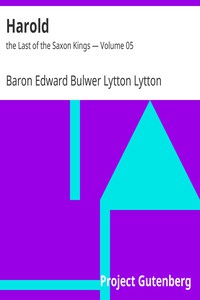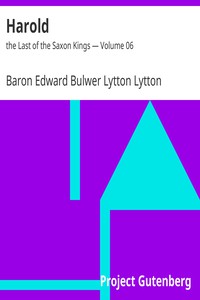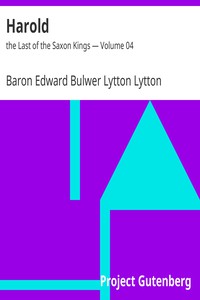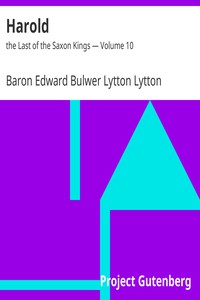Harold : the Last of the Saxon Kings — Complete by Lytton (an ebook reader TXT) 📖

- Author: Lytton
Book online «Harold : the Last of the Saxon Kings — Complete by Lytton (an ebook reader TXT) 📖». Author Lytton
Certainly William de Poitiers ought to have known best; and the probability of his story is to a certain degree borne out by the uncertainty as to Harold’s positive interment, which long prevailed, and which even gave rise to a story related by Giraldus Cambrensis (and to be found also in the Harleian MSS.), that Harold survived the battle, became a monk in Chester, and before he died had a long and secret interview with Henry the First. Such a legend, however absurd, could scarcely have gained any credit if (as the usual story runs) Harold had been formally buried, in the presence of many of the Norman barons, in Waltham Abbey—but would very easily creep into belief, if his body had been carelessly consigned to a Norman knight, to be buried privately by the sea-shore.
The story of Osgood and Ailred, the childemaister (schoolmaster in the monastery), as related by Palgrave, and used in this romance, is recorded in a MS. of Waltham Abbey, and was written somewhere about fifty or sixty years after the event—say at the beginning of the twelfth century. These two monks followed Harold to the field, placed themselves so as to watch its results, offered ten marks for the body, obtained permission for the search, and could not recognise the mutilated corpse until Osgood sought and returned with Edith. In point of fact, according to this authority, it must have been two or three days after the battle before the discovery was made.
FOOTNOTES
1 (return)
Sismondi’s History of France, vol. iv. p. 484.
2 (return)
“Men’s blinded hopes, diseases, toil, and prayer, And winged troubles peopling daily air.”
3 (return)
Merely upon the obscure MS. of the Waltham Monastery; yet, such is the ignorance of popular criticism, that I have been as much attacked for the license I have taken with the legendary connection between Harold and Edith, as if that connection were a proven and authenticated fact! Again, the pure attachment to which, in the romance, the loves of Edith and Harold are confined, has been alleged to be a sort of moral anachronism,—a sentiment wholly modern; whereas, on the contrary, an attachment so pure was infinitely more common in that day than in this, and made one of the most striking characteristics of the eleventh century; indeed of all the earlier ages, in the Christian era, most subjected to monastic influences.
4 (return)
Notes less immediately necessary to the context, or too long not to interfere with the current of the narrative, are thrown to the end of the work.
5 (return)
There is a legend attached to my friend’s house, that on certain nights in the year, Eric the Saxon winds his horn at the door, and, in forma spectri, serves his notice of ejectment.
6 (return)
The “Edinburgh Review,” No. CLXXIX. January, 1849. Art. I. “Correspondance inedite, de Mabillon et de Montfaucon, avec l’Italie.” Par M. Valery. Paris, 1848.
7 (return)
And long before the date of the travesty known to us, and most popular amongst our mediaeval ancestors, it might be shown that some rude notion of Homer’s fable and personages had crept into the North.
8 (return)
“The apartment in which the Anglo-Saxon women lived, was called Gynecium.”—FOSBROOKE, vol. ii., p. 570.
9 (return)
Glass, introduced about the time of Bede, was more common then in the houses of the wealthy, whether for vessels or windows, than in the much later age of the gorgeous Plantagenets. Alfred, in one of his poems, introduces glass as a familiar illustration:
10 (return)
Skulda, the Norna, or Fate, that presided over the future.
11 (return)
The historians of our literature have not done justice to the great influence which the poetry of the Danes has had upon our early national muse. I have little doubt but that to that source may be traced the minstrelsy of our borders, and
 Have you ever thought about what fiction is? Probably, such a question may seem surprising: and so everything is clear. Every person throughout his life has to repeatedly create the works he needs for specific purposes - statements, autobiographies, dictations - using not gypsum or clay, not musical notes, not paints, but just a word. At the same time, almost every person will be very surprised if he is told that he thereby created a work of fiction, which is very different from visual art, music and sculpture making. However, everyone understands that a student's essay or dictation is fundamentally different from novels, short stories, news that are created by professional writers. In the works of professionals there is the most important difference - excogitation. But, oddly enough, in a school literature course, you don’t realize the full power of fiction. So using our website in your free time discover fiction for yourself.
Have you ever thought about what fiction is? Probably, such a question may seem surprising: and so everything is clear. Every person throughout his life has to repeatedly create the works he needs for specific purposes - statements, autobiographies, dictations - using not gypsum or clay, not musical notes, not paints, but just a word. At the same time, almost every person will be very surprised if he is told that he thereby created a work of fiction, which is very different from visual art, music and sculpture making. However, everyone understands that a student's essay or dictation is fundamentally different from novels, short stories, news that are created by professional writers. In the works of professionals there is the most important difference - excogitation. But, oddly enough, in a school literature course, you don’t realize the full power of fiction. So using our website in your free time discover fiction for yourself. 




Comments (0)